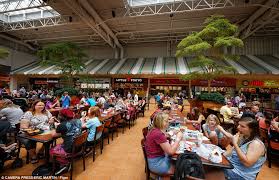US in crisis. The death of the mall
In the developed capitalist economies the financial crisis of 2007 had as its epicenter the real estate sector and the mortgages of poor quality. Central banks rescued the banking system by privatizing profits and making public the cost of the crisis.Now Shops for sale in Gulberg Lahore are avail. And now that the worst of the storm front has passed, the perception that the storm has been controlled is strengthened. That is a wrong and dangerous idea.
The truth is that the problem in the United States has moved from the residential to the malls, the famous and ugly shopping malls. These huge buildings are now at the heart of the next financial hurricane. As in 2007, the effects of bad weather will be felt in the global economy.
Shopping malls in the United States are slowly dying. Empty premises multiply because sales do not cover high incomes and bankruptcies increase every day. Almost no talk of this topic, but the truth is that in the United States is growing every day the number of ghost shopping centers, abandoned or with large open spaces. There is even talk of the Chinese model in which cheap credit and real estate speculation have led to constructions of millions of square meters that today are empty shells supported by millions of tons of concrete, thousands of kilometers of electrical cables and pipes, colossal ecological footprint.
If the successful image of the mall is maintained it is only because some malls remain in good condition. But these centers are the minority: in the United States only 20 percent of shopping centers generate more than two-thirds of the profits of this sector. These shopping centers are located in areas that maintain high density of population with purchasing power or in centers of tourist and economic concentration. The truth is that the crisis in the rest of the shopping centers is a sad reality that will not disappear. It is estimated that in the next two or three years about 800 shopping malls (more than half of the total) will disappear throughout the United States.
Many would think that the main responsibility of the debacle of the mall is due to the boom of online commerce. But the fact is that despite its growth, Internet commerce barely represents 12 percent of the total sales of department stores that serve as an anchor of the malls.
The underlying reason for the new crisis is that the construction of shopping centers in the last two decades has proceeded at a pace much higher than the growth of purchasing power in most US cities. As demand stagnated, more than seven million square meters were built for shopping centers in the last five years.
Why has investment in shopping centers been maintained? The answer is immediate: wrong risk calculations and lots of speculation. This is a sector in which real estate is a guarantee, facilitates the obtaining of financing and allows greater leverage. Investment in shopping centers was offering stable yields that promised to exceed 6 or 7 percent and with a seemingly as solid guarantee as the concrete and steel used in its construction. That explains the rapid growth of installed capacity that now exceeds all projections on the evolution of demand. That is why the stores in the malls offer constant offers and discounts on the whole range of items for sale, which squeezes the profit margins and leads to the opening of bankruptcy contests. As a result, shopping center operators face serious difficulties in dealing with their debt commitments. For the next 18 months it is necessary to refinance about 130 billion dollars in loans for the shopping center sector, an operation that is not easy to announce.
The big difference from the coming crisis is that the main creditors are not the big banks, but so-called institutional investors such as pension funds and insurance companies, as well as other financial agents - especially hedge funds hedge funds - and credit unions. The implications for the financial system are more serious than those of the 2007 crisis because the rescue of insurance companies and pension funds is announced almost impossible. The cascading effects on retiree income and the collapse of tax revenue (for property taxes) are multiple and will be hard to reverse: selling one of these centers is much more complicated than getting rid of a thousand houses. Unlike the closure of a factory and the loss of jobs, the closure of a shopping center can not be explained by easy rhetoric about globalization or a bad commercial treaty. The twilight of shopping malls is due to structural problems of advanced capitalism.



Comments
Post a Comment